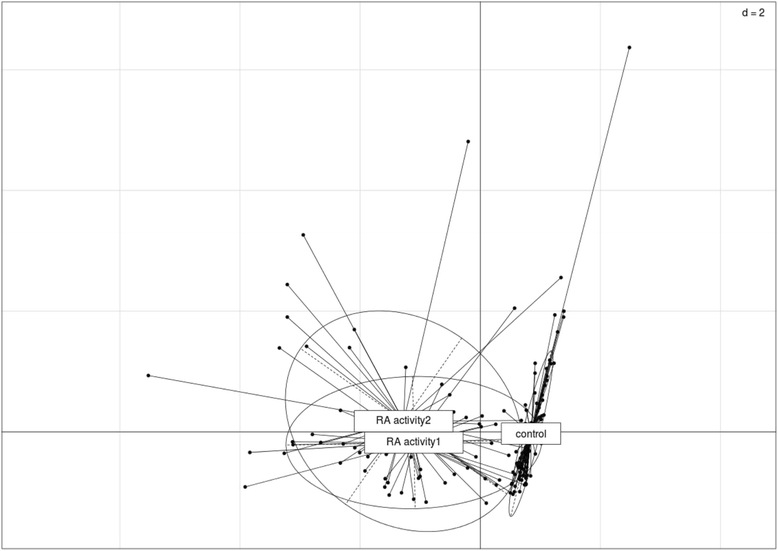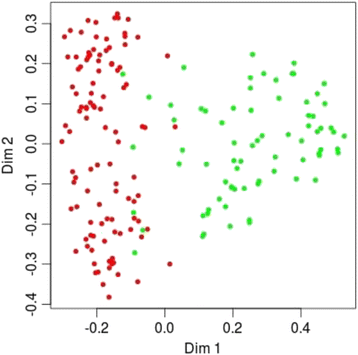Circulating DNA in rheumatoid arthritis: pathological changes and association with clinically used serological markers
- PMID: 28464939
- PMCID: PMC5414163
- DOI: 10.1186/s13075-017-1295-z
Circulating DNA in rheumatoid arthritis: pathological changes and association with clinically used serological markers
Abstract
Background: Early diagnosis of rheumatoid arthritis (RA) is crucial to providing effective therapy and often hampered by unspecific clinical manifestations. Elevated levels of extracellular circulating DNA (cirDNA) in patients with autoimmune disease were found to be associated with etiopathogenesis. To our knowledge, this is the first study to investigate the putative diagnostic use of cirDNA in RA and its association with disease activity.
Methods: Blood samples were taken from 63 healthy subjects (HS) and 74 patients with RA. cirDNA was extracted from plasma and cell surface-bound cirDNA fractions (csbDNA). cirDNA concentration was measured by quantitative real-time polymerase chain reaction. Rheumatoid factor was analyzed by immunonephelometry, whereas C-reactive protein and anticitrullinated protein/peptide antibodies (ACPA) were detected by enzyme-linked immunosorbent assay.
Results: Plasma cirDNA was significantly elevated in patients with RA compared with HS (12.0 versus 8.4 ng/ml, p < 0.01). In contrast, nuclear csbDNA (n-csbDNA) was significantly decreased (24.0 versus 50.8 ng/ml, p < 0.01), whereas mitochondrial csbDNA (m-csbDNA) was elevated (1.44 × 106 copies/ml versus 0.58 × 106 copies/ml, p < 0.05) in RA. The combination of csbDNA (mitochondrial + nuclear) with ACPA reveals the best positive/negative likelihood ratios (LRs) for the discrimination RA from HS (LR+ 61.00, LR- 0.03) in contrast to ACPA (LR+ 9.00, LR- 0.19) or csbDNA (LR+ 8.00, LR- 0.18) alone.
Conclusions: Nuclear and mitochondrial cirDNA levels in plasma and on the surface of blood cells are modulated in RA. Combination of cirDNA values with ACPA can improve the serological diagnosis of RA.
Keywords: Antibodies to citrullinated protein/peptide; Circulating nuclear DNA; Mitochondrial DNA; Real-time PCR; Rheumatoid arthritis; Rheumatoid factor.
Figures


Similar articles
-
Serum 14-3-3η is a novel marker that complements current serological measurements to enhance detection of patients with rheumatoid arthritis.J Rheumatol. 2014 Nov;41(11):2104-13. doi: 10.3899/jrheum.131446. Epub 2014 Aug 15. J Rheumatol. 2014. PMID: 25128504
-
Increased levels of neutrophil extracellular trap remnants in the serum of patients with rheumatoid arthritis.Int J Rheum Dis. 2018 Feb;21(2):415-421. doi: 10.1111/1756-185X.13226. Epub 2017 Nov 6. Int J Rheum Dis. 2018. PMID: 29106059
-
Clinical and serological analysis of patients with positive anticyclic citrullinated Peptide antibodies referred through a Rheumatology Central Triage System.J Rheumatol. 2015 May;42(5):771-7. doi: 10.3899/jrheum.141054. Epub 2015 Feb 1. J Rheumatol. 2015. PMID: 25641884
-
Anti-citrullinated protein antibodies (ACPA) in early rheumatoid arthritis.Mod Rheumatol. 2012 Feb;22(1):15-20. doi: 10.1007/s10165-011-0486-8. Epub 2011 Jul 6. Mod Rheumatol. 2012. PMID: 21732051 Review.
-
The influence of biological and lifestyle factors on circulating cell-free DNA in blood plasma.Elife. 2021 Nov 9;10:e69679. doi: 10.7554/eLife.69679. Elife. 2021. PMID: 34752217 Free PMC article. Review.
Cited by
-
Circulating Free DNA and Its Emerging Role in Autoimmune Diseases.J Pers Med. 2021 Feb 20;11(2):151. doi: 10.3390/jpm11020151. J Pers Med. 2021. PMID: 33672659 Free PMC article. Review.
-
Expanding role of deoxyribonucleic acid-sensing mechanism in the development of lifestyle-related diseases.Front Cardiovasc Med. 2022 Sep 13;9:881181. doi: 10.3389/fcvm.2022.881181. eCollection 2022. Front Cardiovasc Med. 2022. PMID: 36176986 Free PMC article. Review.
-
Changes in circulating cell-free nuclear DNA and mitochondrial DNA of patients with adolescent idiopathic scoliosis.BMC Musculoskelet Disord. 2019 Oct 25;20(1):479. doi: 10.1186/s12891-019-2869-5. BMC Musculoskelet Disord. 2019. PMID: 31653238 Free PMC article.
-
Reduced Maternal Circulating Cell-Free Mitochondrial DNA Is Associated With the Development of Preeclampsia.J Am Heart Assoc. 2022 Jan 18;11(2):e021726. doi: 10.1161/JAHA.121.021726. Epub 2022 Jan 11. J Am Heart Assoc. 2022. PMID: 35014857 Free PMC article.
-
Mitochondrial Fraction of Circulating Cell-Free DNA as an Indicator of Human Pathology.Int J Mol Sci. 2024 Apr 10;25(8):4199. doi: 10.3390/ijms25084199. Int J Mol Sci. 2024. PMID: 38673785 Free PMC article.
References
-
- Nishimura K, Sugiyama D, Kogata Y, Tsuji G, Nakazawa T, Kawano S, et al. Meta-analysis: diagnostic accuracy of anti-cyclic citrullinated peptide antibody and rheumatoid factor for rheumatoid arthritis. Ann Intern Med. 2007;146(11):797–808. doi: 10.7326/0003-4819-146-11-200706050-00008. - DOI - PubMed
-
- Sokolove J, Schiff M, Fleischmann R, Weinblatt ME, Connolly SE, Johnsen A, et al. Impact of baseline anti-cyclic citrullinated peptide-2 antibody concentration on efficacy outcomes following treatment with subcutaneous abatacept or adalimumab: 2-year results from the AMPLE trial. Ann Rheum Dis. 2016;75(4):709–14. doi: 10.1136/annrheumdis-2015-207942. - DOI - PMC - PubMed
Publication types
MeSH terms
Substances
LinkOut - more resources
Full Text Sources
Other Literature Sources
Medical
Research Materials

